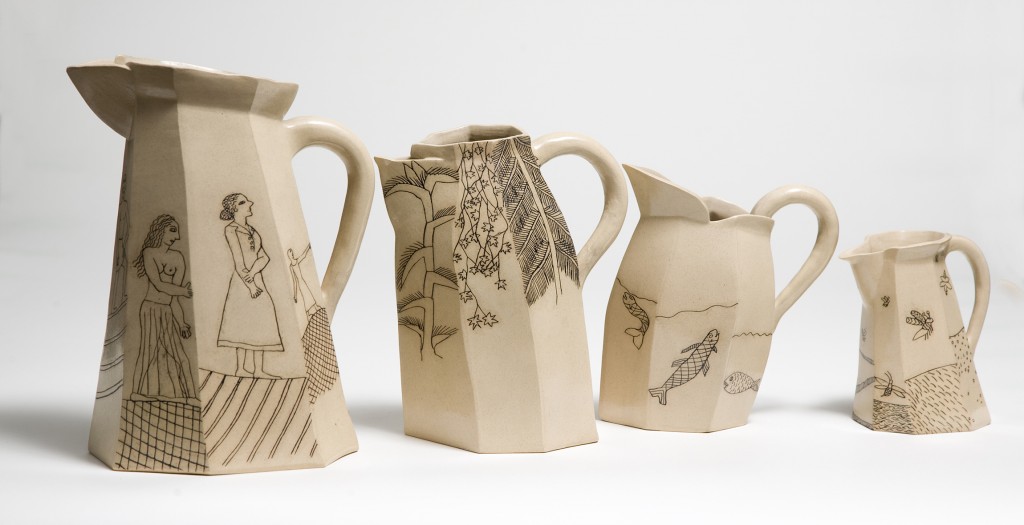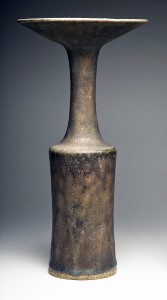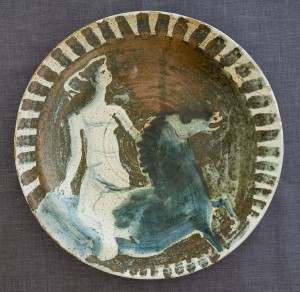
This week I am returning to ‘The Bishop Otter Art Collection: A Celebration’ exhibition at Chichester University to rediscover their remarkable British Studio Pottery.

The collection includes Modern British paintings as well as studio ceramics, sculpture and tapestries. Visiting professor Gill Clark explains the philosophy behind the collection “Sheila McCririck and the Bishop Otter College Principal Betty Murray founded the collection in the years after the Second World War. They both believed in the civilising influence of art and the educative value of its ability to challenge.” With this philosophy behind the collection it is un-surprising that the Bishop Otter teaching college should have also collected the work of artisan, art potters.
Britain led the world in the field of studio ceramics in the 20th century.
The British ceramics tradition is tied up with the vernacular. From medieval times its production has been widespread and diverse.
The artisan artist is at work in studio ceramics. Form, colour and decoration come together creating objects which are not only beautiful but, very often, useful as well. This is very much in the tradition of William Morris and the Arts and Crafts Movement.

Bernard Leach (1887-1979) is considered to be the most influential potter of the 20th century. He was born in Hong Kong and lived in Japan and Singapore. The Japanese tradition of artisan artists was fading when Leach decorated his first pot there in 1909. In 1920 he returned to England with the Japanese potter, Shoji Hamamda. Bernard Leach was persuaded to set up his workshop in St Ives. His lectures and writing would have a profound influence on a generation of British potters. Gill Clark points out that Norah Braden was the college’s first specialist pottery tutor and that she had been a pupil of Bernard Leach. His work is represented in the collection by the beautiful stoneware jug seen here.
Bernard Leach was initially critical of the work of Lucie Rie (1902-1995) but they would become great friends. In contrast to the influences of the rustic folk tradition and Chinese Sung apparent in Bernard Leach’s work Rie’s pots have a metropolitan, modernist quality. She enjoyed turning on the potter’s wheel but despite her remarkable control her pots never seem tight or mechanical. The beauty of her vases and their exceptional form cause your heart to quicken. It is readily apparent to the eye why she transformed modern ceramics.
Other studio ceramic gems in the collection and exhibition include the Sussex based ceramicist, Eric Mellon’s (1925-2014) ‘Horse and Rider’ dish. His years of research and experimentation into ash glazes brought him international recognition both as an artist, ceramicist and scientist. For Eric his art was his calling and vocation.

Alison Britton’s (b.1948) sharp-edged clay jugs seem to depict different facets of a landscape which in turn include human figures, trees, fish and insects. Their decoration has an immediacy reflecting Britton’s spontaneous method of drawing in response to the asymmetric planes of the jugs.
‘The Bishop Otter Art Collection: A Celebration’ runs until 9th October 2016 at the University of Chichester Otter Gallery and Pallant House Gallery. Gill Clarke has published an insightful accompanying book about the collection and its formation which is on sale at both venues. For more information and opening times go to www.pallant.org.uk and www.chi.ac.uk/current-exhibitions/bishop-otter-collection-celebration.
By Rupert Toovey, a senior director of Toovey’s, the leading fine art auction house in West Sussex, based on the A24 at Washington. Originally published in the West Sussex Gazette.